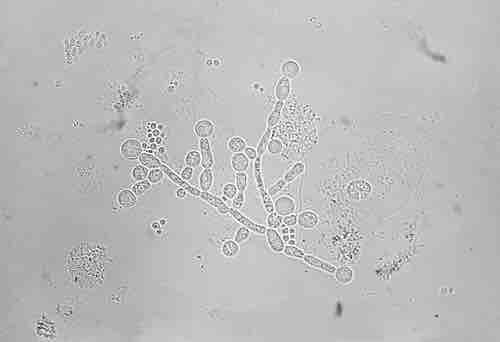Candidal vulvovaginitis or vaginal thrush is an infection of the vagina's mucous membranes by Candida albicans . Up to 75% of women will have this infection at some point in their lives, and approximately 5% will have recurring episodes. It is the second most common cause of vaginal inflammation after bacterial vaginosis.

Candida albicans
Tramsmission photomicrograph showing a number of Candida albicans chlamydospores.
It is most commonly caused by a type of fungus known as Candida albicans. The Candida species of fungus is found naturally in the vagina, and is usually harmless. However, if the conditions in the vagina change, Candida albicans can cause the symptoms of thrush. Symptoms of thrush can also be caused by Candida glabrata, Candida krusei, Candida parapsilosis, and Candida tropicalis. Non-albican Candida are commonly found in complicated cases of vaginal thrush such that first line treatment is ineffective. These cases are more likely in immunocompromised patients.
It is not known exactly how changes in the vagina trigger thrush, but it may be due to a hormone (chemical) imbalance. In most cases, the cause of the hormonal changes is unknown. Some possible risk factors have been identified, such as taking antibiotics.
The symptoms of vaginal thrush include vulval itching, vulval soreness and irritation, pain or discomfort during sexual intercourse (superficial dyspareunia), pain or discomfort during urination (dysuria) and vaginal discharge, which is usually odorless. The discharge can be thin and watery, or thick and white, like cottage cheese.
In addition to the above symptoms of thrush, vulvovaginal inflammation can also be present. The signs of vulvovaginal inflammation include erythema (redness) of the vagina and vulva, vagina fissuring (cracked skin), oedema (swelling from a build-up of fluid), also in severe cases, satellite lesions (sores in the surrounding area). This is rare, but may indicate the presence of another fungal condition, or the herpes simplex virus (the virus that causes genital herpes).
While vulvovaginal candidiasis is caused by a the yeast Candida there are many predisposing factors:
- Infection occurs in about 30% of women who are taking a course of oral antibiotics. The evidence of the effect of oral contraceptives is controversial.
- In pregnancy, changes in the levels of female sex hormones, such as estrogen, make a woman more likely to develop a yeast infection. During pregnancy, the Candida fungus is more prevalent (common), and recurrent infection is also more likely.
- Frequency of sexual intercourse appears to be related to the frequency of infections, however infections often occur without sex. Tight-fitting clothing, such as tights and thong underwear, do not appear to increase the risk. Neither do personal hygiene methods.
- Those with poorly controlled diabetes have increased rates of infection while those with well-controlled diabetes do not.
- The risk of developing thrush is also increased in a immunodeficiency, for example, by an immunosuppressive condition, such as HIV or AIDS, or receiving chemotherapy. This is because in these circumstances the body's immune system, which usually fights off infection, is unable to effectively control the spread of the Candida fungus.